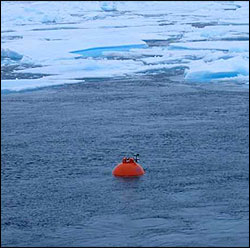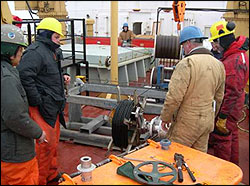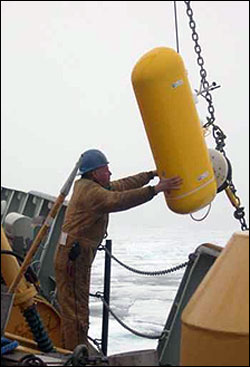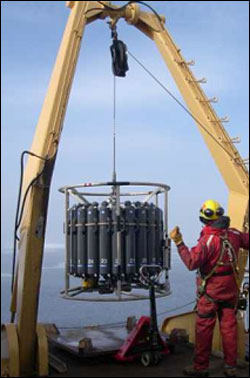Please note: You are viewing
the unstyled version of this website. Either your browser does not support CSS
(cascading style sheets) or it has been disabled. Skip
navigation.
Sarah Zimmermann, IOSAugust 13-14, 2004
We recovered the WHOI-A mooring (75N, 150E) on August 10. It went really well; we did a close range on the upper transponder (50m below surface), spent an hour or so making a hole in the right area, released the mooring ~100m from the ship, and had the top float hooked and on deck ½ an hour later. The bottom of the mooring also came to the surface ~40 minutes later, and this posed some difficulty because it came up ~300m away from the ship with ice in between. We kept reeling in the mooring line from where we were, but eventually the tension grew too large with the line getting hung up on the ice. With ¾ of the mooring on deck, including the moored profiler, it was simplest to cut the mooring line, move to the tail end of the mooring, and pull the mooring in tail first. It turned out the tail had wuzzled (tangled) with an earlier section of the line as it rose to the surface- so it would have been very difficult to pull towards the ship under/through the ice. The whole operation took ~4 1/2 hours with a very smooth operation on deck. Not bad!! After the recovery we steamed west then east for a CTD/Rosette station on either side of the mooring. This 36 hours break gave the mooring guys a chance to turn around the recovered mooring and calibrate the moored profiler's CTD with our Rosette CTD. The Rosette and net work is going well; we've been able to deploy simultaneously most of the times. Our pace is going pretty well with mostly 2 Rosette casts per day, occasionally 1 cast. Amanda, the net queen, gave us a presentation the last night of what she is doing and some pictures through the microscope. Very nice to see- and the science and crew enjoyed it. It's always nice to get a view into the different aspects of the same project. Back on the mooring site the WHOI-A mooring was redeployed without incident in about 6 hours. The winds are down but the deck was icy from the foggy cold. Gray days in the ice.
Last updated: October 7, 2019 | ||||||||||||||||||||
Copyright ©2007 Woods Hole Oceanographic Institution, All Rights Reserved, Privacy Policy. | ||||||||||||||||||||






